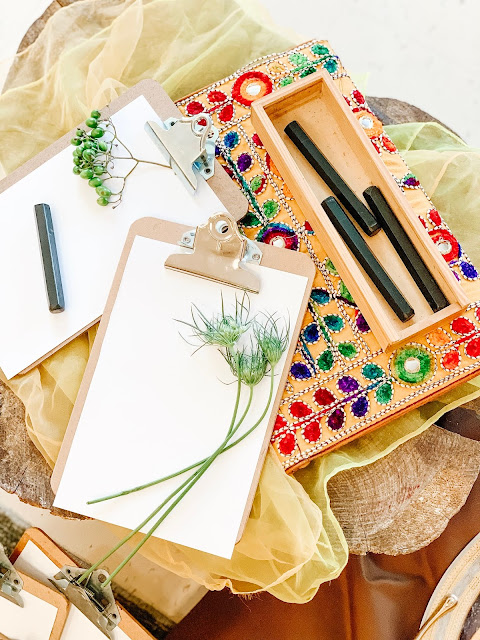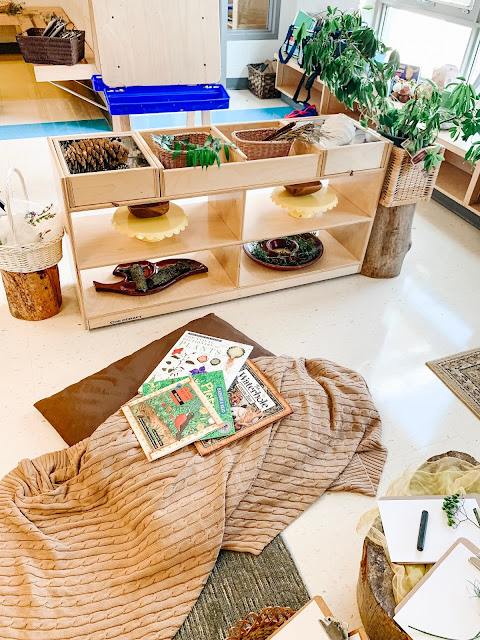As you all know, I have been instructing the Kindergarten Additional Qualification course for years at York University to educators from all across Ontario, and as of most recently (with our online platform) from other parts of the world! In my Spring and Summer courses, we had participants from as far as Indonesia and India.
I enjoy sharing my passion for designing learning spaces filled with limitless possibilities to explore and inquire!
In this post, I will be discussing a process that I went through when visiting one of my former Kindergarten AQ students' public school classrooms and transforming a corner that is near her window area.
Something that I have really wanted to do ever since my kids were born, is find the time to give back to the education community. A community that, they too are already apart of as students! I thought about what my skills are, and how I might be helpful to someone teaching in childcare or elementary school. Giving back means that I could potentially have a positive effect on another child or group of children's lives. That is pretty powerful! What made most sense to me, therefore, was supporting with classroom setup using whatever this specific Teacher/RECE team already had in their cupboards or storage. I'm very familiar with this process, as it is something that I do often in my own studio space, for hands-on experiential workshops that I present, and even for school boards/independent schools who have hired me to create learning environments.
Going into this classroom, I knew that I would be extra hands for an already incredible/capable team of Kindergarten Teacher and Designated Early Childhood Educator. Every educator has their own ideas of how a space could be setup, and our choices often require careful reflection and negotiation.
I suggested to the team that perhaps I could work on a micro space of their classroom - a smaller area by their windows. The sun was shining and I was really inspired by the green shrubs and plants growing, something quite rare to see outside a Kindergarten classroom. My motivation was to create a place where any/all learning could occur! I did not want to limit myself to "mathematics," or "sensory," or "painting." I hoped to make an organic space that would inspire the learning of children and that would encourage an emergent curriculum.
The team was very welcoming, and felt comfortable allowing me to see what they had in their storage. I began by pulling out all of what caught my attention - the beautiful and unique materials that intrigued me. They had so many to choose from! I can actually say, that I was feeling a little overwhelmed!!!
Here is what I added:
- mirrors to the window sill and fabric to capture the natural light
- earthy tones in the carpet, pillows, baskets and trays along with accessories/materials that had the colours found in nature (blues for the sky, browns for the earth, greens for the plants, yellows for the sun, etc.)
- real objects from my nature walk with the team's children (they were there during the setup time and in junior and intermediate grades which was so helpful!) - together we found pine cones, rocks, leaves, flowers, branches, etc.
- over-sized pillows to lay on with a large wooden log as a table - ample space to sit on the carpet/ground as well as to work kneeling or standing around the shelves and counters
- loose parts, reading/writing resources, visual art tools
- art work that had been previously made and framed to preserve learning from a another school year which might inspire further learning of the new group
Here is what I learned:
- designing learning environments is a process and authentic spaces are always in constant transformation
- learning spaces can change based on what the children do, their specific needs, or the desires of the educators
- if we capture photographs or video clips of our space before the transformation, after, and then again once the children play/learn, then we can study the images to see what can be added or taken away
- documenting our learning environment and the interactions of the students can be part of and inform our research - it can help us to really see the children and reveal all the possible directions
- every educator/artist approaches materials differently - some speak to them while others don't interest them at all - a lot has to do with our personal style or preferences
- challenge yourself not to go out and spend loads of money - start to use what you already have in different combinations/arrangements
- a space doesn't need a name like "the building area," or "writing area," or "reading area," for children to use materials and build, write, or read, etc. - the greatest spaces integrate all types of learning/learning styles
- the process of designing this micro space can and in my opinion should be happening beyond childcare and kindergarten - this is how I would go about setting up my Grade 1-3, 4-8 or even school library (the books' content/level and resources would change)
- even without the children in the room, I already saw so many opportunities to improve the area by reflecting, revisiting the photographs and rethinking - our colleagues, networks and even students can help in these discussions and co-creation opportunities *in my particular case, using the photos in my post I appreciated my details but I still notice that I attempt to place too many objects out at one time
- the longer you have in a space (hours, days, weeks, months, years) the more potential it has to evolve
- educational spaces are always in transformation and should not only be considered or "setup" during the week before school begins - this important work is ongoing throughout the school year(s) so don't be afraid to make big changes at any point that you feel the inspiration
- a space will never be perfect or feel finished, so do not pressure yourself to do it all before September - it is a learning process - if you do not change anything you are no longer growing as an educator
- remember that classrooms are a true work of art and special gift to children, families and the education community
I accomplished this micro learning space in three hours, without air-conditioning or taking any breaks. When I begin a transformation, it's very difficult for me to stop! I get into the zone or reach my creative flow, especially since you can continuously rework the placement of your resources and add or remove certain details in preparation for the children to arrive!
Wishing this Kindergarten team and their class a wonderful start and hoping that this post might have inspired some of your thinking along the way! For a video tour of the space, please visit my instagram page.
Next week, I am helping another kindergarten team from a different school board, so please stay tuned for more learning!!!
There are no two individuals who use materials or see a space in quite the same way, but that is part of the beauty of building trusting relationships, working together, and embracing our unique perspectives.
All learning contexts (e.g., classrooms), are a true work of art, and reflection of our current thinking. The spaces that we design are a special gift to children, families and the education community at large. For it is within these environments where we have the power and potential to inspire life-long learning.
-Joanne Marie Babalis
































We are really grateful for your blog post. You will find a lot of approaches after visiting your post. I was exactly searching for. Thanks for such post and please keep it up. Great work.
ReplyDeleteKevlar jeans
Kevlar shirts
I’m going to read this. I’ll be sure to come back. thanks for sharing. and also This article gives the light in which we can observe the reality. this is very nice one and gives indepth information. thanks for this nice article...
ReplyDeletearmored motorcycle hoodie
motorcycle cargo pants
I like your post. It is good to see you verbalize from the heart and clarity on this important subject can be easily observed...
ReplyDeleteKevlar motorcycle gloves
Kevlar motorcycle shirts
I wanted to thank you for this excellent read!! I definitely loved every little bit of it. I have you bookmarked your site to check out the new stuff you post.
ReplyDeletewomens biker apparel
Best motorcycle jeans
https://www.guest-articles.com/education/how-to-pass-your-ncp-515-exam-at-first-attempt-02-10-2020
ReplyDeletehttps://www.lily.fi/blogit/examcertification/the-easy-and-best-way-to-pass-huawei-h19-370-exam-dumps/
Absolutely! Learning spaces continuously evolve to meet the dynamic needs of students and educators not just at the start of the school year. Fabrication and Welding Services by RTS Renovation play a vital role in this transformation by crafting customized, durable structures that adapt to modern educational environments and foster effective learning year-round.
ReplyDeleteLearning spaces evolve constantly, much like the timeless appeal of a Biker Motorcycle Vintage Brown Jackett blending classic foundations with new layers of experience, both before school starts and beyond.
ReplyDeleteClasses have been really interactive lately. The Enneagram
ReplyDelete